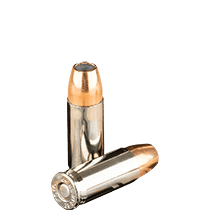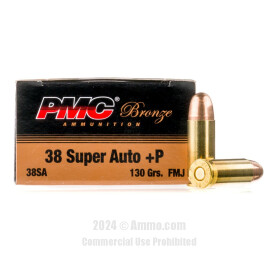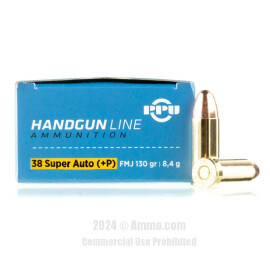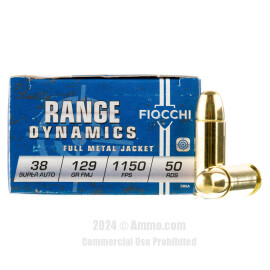
38 Super Ammo For Sale
History of 38 Super Ammo
Colt released the .38 Super Automatic cartridge in 1929, as a hotter and heavier load than the .38 Automatic Colt Pistol (ACP) that it was modeled after. The .38 Super is in a twin case to its parent and designed for Colt’s semi-automatic, magazine-fed pistol in a 1911 style.
The ammo features a bullet of the same size and weight, a .356-inch lead projectile with a standard weight of 130 grain (gr), loaded into a semi-rimmed (and sometimes rimless), straight-walled case that measures .900 inch. When fit with the bullet, the round comes in with a total length of 1.280 inches.
The Super ammunition is loaded with more powder, making it a significantly more powerful round than the .38 Auto. The original ACP round had the 130 gr cartridge traveling at a velocity of 1,050 feet per second (fps). Under the higher pressure and loaded with more powder, the .38 Super Auto pushes that same 130 gr projectile to a velocity of 1,280 fps.
The Super .38 uses a small pistol primer and is loaded to a maximum pressure of 36,000 pounds per square inch (psi). This pressure leads to a high-speed, hot round with a flat trajectory and long-distance travel – perfect for handgun hunting America’s small to medium game.
For a brief period of time, the .38 Automatic was the most powerful automatic pistol cartridge in the country. It was also one of the first munitions that used velocity, instead of bullet size, to get performance results (a common occurrence with modern ballistic technology, hence the popularity of the 9mm and .380 ACP).
The Development of the .38 Automatic
Introduced by Colt’s Manufacturing Company in 1929, it’s been assumed that the .38 Super was designed as an improvement on the .38 ACP. Yet, there’s some discrepancy to the origins of the caliber and a bit of a what-came-first conundrum to the ammo’s history.
The first, and most common, school of thought is that law enforcement agencies of the time drove the development of the caliber by demanding a pistol cartridge with a higher power than that available in the .38 Auto and 9mm, but that also had better performance than the .45 ACP. Colt decided to solve the problem by upping the ante on the .38, increasing it to its full capacity of power.
The second theory of the ammunition’s development is that the ammunition was an afterthought. Colt released the “Super .38” Automatic – a new, 1911-style single-stack pistol designed to fire the .38 ACP. As the new firearm made its way into the hands of gun enthusiasts, they realized it was strong enough to handle an increase in power, something the original .38 Auto pistols (like the M1900 and the M1902) were not capable of.
Soon after, handloaders begin to make their own rounds, increasing the load powder and power, and making a hot .38 Auto. When Colt realized this, they, too, started manufacturing a hotter load in the same sized ammo as the original .38 ACP, and simply labeled it .38 Super to indicate its use for their “Super” pistol, not the original .38 Autos.
Regardless of its origins, the ammunition hit the market and was quickly accepted in both law enforcement and civilian circles. The round had more power, propelling a 130 gr projectile at over 1,200 fps.
The FBI is reported to have adopted the cartridge, partially because of its performance and carry capacity (with 9 to 11 rounds in a single stack, its capacity was significantly larger than the .38 Special, one of the most popular revolver cartridges of the time), but also because the .38 Super could punch through the body armor of the day and still deliver a lethal wound at 50 yards.
Remember, this was the era of Prohibition and the American gangster. Law enforcement needed something powerful that they could use to protect themselves and for apprehending criminals. The .38 Super was able to penetrate the era’s car doors and automobile glass and suddenly, mobsters could no longer use their cars as shields during escape.
It wasn't just the police who used the .38 Super. Notorious criminal John Dillinger had a Colt .38 Super when he was captured. Also in his possession was a custom-built Colt M1911A1 chambered in .38 Super that fired in full automatic. It was modified with a Cutts compensator, the fore grip used on a Thompson submachine gun, and an extra capacity magazine, increasing its deadliness.
While the .38 Super was popular, it began to dwindle with the release of the .357 Magnum in 1935. Many officers missed their revolvers and, although the calibers saw similar performance ballistics, the majority of law enforcement switched back to wheel guns, which they stayed with for another 50-plus years.
Then, when the U.S. joined World War II in 1941, gun manufacturers, including Colt, turned their focus from law enforcement and civilian weapons to military arms and artillery. With the demanding war controlling the firearms and ammunition developments, the .38 Super was forced into a hibernation of sorts for nearly 40 years.
In 1974, the .38 Super popped on the firearm scene again when Sporting Arms and Ammunition Manufacturers’ Institute (SAAMI) added the +P designation to the .38 Super’s headstamp, where it’s remained since. This classification lessens the likelihood of the hot round ending up loaded in a .38 Auto gun that can’t handle it, like a vintage Colt M1900 or M1902.
In the early 1980s, thanks to Rob Leatham and Brian Enos, both firearm enthusiasts and competition shooters, the .38 super was reborn among competitive shooters and its popularity surged. In shooting sports, not just any caliber can be used – each division has a certain formula for power and force, which keeps the competition fair.
In the International Practical Shooting Confederation (IPSC), the primary cartridge was the .45 ACP, as the organization requires powerful ammunition due to basing its shooting on self defense. What Leatham and Enos discovered was that the .38 Super Auto had enough power to meet the IPSC requirements, but was easier to shoot due to its lesser recoil and had the bonus of a higher magazine capacity.
The Performance of .38 Super Ammo
As far as small ammunition goes, the .38 Super ballistics are impressive. Its muzzle energy easily exceeds 500 foot pound force (ft·lb) with a muzzle velocity exceeding 1,300 fps with a full metal jacket bullet. Its recoil is comparable to the 9mm and much easier to handle than with the .45 ACP.
When it comes to size, it’s easy to see that the .38 Super is slightly larger than the 9mm and, even though they look remarkably similar, the Super is more powerful.
The .38 Super Auto, although smaller than the .45 ACP, meets many of the larger ammo’s performance stats. In comparison, the .38 Super has deeper penetration, but not quite as much stopping power, especially if the .45 Auto is a self-defense round.
Regarding magazine capacity, the .38 Super enjoys an advantage over the .45 ACP in a 1911-style frame. In a single-stack magazine, which is standard in this style, the Super fits 9 to 11 rounds, compared to the average of seven for the .45 ACP.
It’s a proven, well-balanced cartridge that delivers what shooters need, whether they’re hunting, shooting at the range, or carrying concealed.
The Popularity of the .38 Super Automatic
While the .38 Super’s popularity has never reached its initial gains in the U.S., it has elsewhere in the world. The .38 Super has found a home in Canada, Mexico, Australia, and South America, where the government forbids civilians from owning firearms chambered in a military cartridge, such as the 9mm or .45 ACP.
This caliber is so common in Latin America, that in the American Southwest, when law enforcement finds a .38 Super at a homicide scene, it’s almost always from south of the border.
Firearms Chambered for the .38 Super
Although .38 Super ammo easily fits into pistols chambered for the .38 Auto (remember, they’re the same size), the Super ammunition should never be fired from these guns, which were not made to handle the hot load’s pressure and force.
It does fit in the aforementioned Colt Super .38 Automatic, which was basically a Colt M1911. In the 90 years since its release, the .38 Super tends to find itself chambered in 1911-style pistols.
Although most shooters won’t be able to get their hands on the handful of Thompson submachine guns the FBI requested to be modified to fit the .38 Super, there are a range of semi-automatic pistols available. Most are specifically designed for either competition shooting or small-to-medium game hunting.
Types of .38 Super Automatic Ammunition
Like most ammunitions, the .38 Super ammo comes in a variety of styles. The two most common forms of the ammo are the full metal jacket and the jacketed hollow point.
Full metal jacket (FMJ) ammo is the traditional cartridge for semiautomatic pistols. These rounds feature a lead bullet that is jacketed in a harder metal, most often copper. This jacket helps the projectile keep its shape, allowing for more force on impact and deeper penetration. These rounds are often used for target practice and plinking. And for shooters looking for cheap .38 Super ammo, FMJ cartridges are most often the best bet.
Jacketed hollow point (JHP) rounds are similar to FMJ, with a lead projectile coated in a harder metal jacket. The difference between the two is that while the FMJ bullet is a solid sphere, the JHP has a hollow point that reaches into the bullet’s center. This hollow point causes the bullet to expand on impact, creating a larger entrance wound, increasing stopping power, and slowing the bullet’s penetration. When shopping for ammunition, shooters can sometimes find JHP .38 Super bulk ammo, which keeps it more affordable.
Variations of the .38 Super Auto
Because the .38 Super round is most often chambered in 1911-style semi-automatic pistols, shooters sometimes experienced issues with the rounds feeding into the firearm from the magazine. In double-stack mags, this was even more problematic.
These issues created a drive from ammunition manufacturers to improve on the cartridge in an attempt to improve feeding. This was most often accomplished by reducing, and in some cases eliminating, the casing’s rim.
In this path toward a rimless round, multiple variations of the .38 Super sprang into the market. The most common cartridges that were born from the .38 Super include:
- .38 Super Comp
- .38 Super Lapua
- .38 Super RL (Armscor)
- .38 TJ (Todd Jarrett)
Common Names for the .38 Super
According to the Sporting Arms and Ammunitions Manufacturers’ Institute (SAAMI), the technical name of the ammo is the .38 Super +P, but shooters can find the ammunition referenced in multiple ways:
- .38 Colt Super Automatic
- .38 Super Automatic
- .38 Super Auto
- .38 Superauto
- .38 Super ACP
- .38 Super +P
- Super .38
- 9x23mmSR
- 9x23mmSR +P
Any and all of these names work for the .38 Super and can be used interchangeably. Sometimes, shooters may see the ammunition listed as the 38 Super or the 38 Super Auto, without the decimal point. While the meaning of these terms is rightly conveyed, they’re grammatically wrong.
The number at the beginning of the caliber name is not just a random number, but a measurement of the bullet’s diameter. In this case, it means .38 inch. So to eliminate or exclude the decimal point negates its meaning. And while people still understand what the name means, it doesn’t make it right.
While the .38 Super has never reached the popularity of other semi-automatic rounds, it hasn’t died off either, even when faced with years of adversity and obscurity. This, in and of itself, says something about the ammunition: that it’s powerful and effective and efficient. Chances are the .38 Super will never reach the popularity of the 9mm or the .45 Auto, but for those who love it and shoot it, the Super is here to stay.
38 Super Ballistics: Chart of Average 38 Super Ballistics
Note: This information comes from the manufacturer and is for informational purposes only. The actual ballistics obtained with your firearm can vary considerably from the advertised ballistics. Also, ballistics can vary from lot to lot with the same brand and type load.
| 38 Super Bullet WEIGHT | Muzzle VELOCITY (fps) | Muzzle ENERGY (ft. lbs.) | Mid-Range TRAJECTORY (in.) | Barrel Length (in.) | |||||
|---|---|---|---|---|---|---|---|---|---|
| Muzzle | 50 yds. | 100 yds. | Muzzle | 50 yds. | 100 yds. | 50 yds. | 100 yds. | ||
| 115 Grain +P | 1130 | 1016 | 938 | 326 | 264 | 225 | 1 | -9.5 | n/a |
| 115 Grain +P | 1300 | 1145 | 1040 | 430 | 335 | 275 | 0.7 | 3.3 | 5" |
| 125 Grain +P | 1215 | 1100 | 1015 | 425 | 350 | 300 | 0.8 | 3.6 | 5" |
| 130 Grain +P | 1215 | 1100 | 1015 | 425 | 350 | 300 | 0.8 | 3.6 | 5" |
| 147 Grain +P | 1100 | 1050 | 1000 | 395 | 355 | 325 | 0.9 | 4 | 5" |
Customer Reviews
-
spike said:
Great ammo no problems shoot
-
jstraw said:
Excellent availability in the tight ammo market. Thanks. For 38 Super the Fiocchi is as good as it gets for regular target shooting.
-
Bikeboy said:
Will reorder.
-
Shadow 2 said:
I have a Witness 38 Super. Eaa recommends you should not use +P ammo in this weapon.I use Fiocchi 129gr FMJ or Armscor 125gr FMJ. I fired 400rds of each,so far no problem.I like this ammo and I will keep on using it.As for Ammo Net,this is a great place to shop.There prices are fair and there service is great and fast.The people there care about what you want and need.After you order,they will contact you to make sure everything went well.What more could you ask for.Thanks Ammo Net.




















